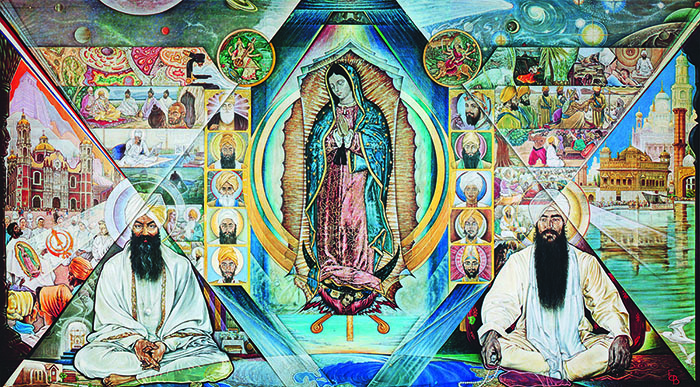
This unique mural was painted between 1973 and 1975 by the renowned mural artist, Edward O’Brien. This man of Christ, through the symbol of the Adi Shakti, moved into truly Universal consciousness: he realized that the beloved Lady of Guadalupe and the Sikh symbol of the Adi Shakti point to that same Divine Power which mothers all of Creation. Through his interfaith work of art, we see the movement among all sentient beings to experience and share the Divine.
The many historic and spiritual elements of this mural center around two depictions of the feminine aspect of God.
One symbol, Our Lady of Guadalupe, is at the center of the mural, as well as the left side of the mural as she appeared on the poncho of Juan Diego in 1531. She is a beloved image of Mother Mary, particularly for Catholics.
The second symbol depicts the Adi Shakti symbol, embedded within the central Lady. Also, the image of Our Lady on Juan Diego’s shawl is filtered and projected through an Adi Shakti. Mr. O’Brien experienced that this Lady was not only the Mother of the Americas, but that she was the Cosmic Mother of the Universe. He dedicated the last years of his life to painting depictions of her. While residing in Santa Fe and becoming friends with the Sikh community, he learned about the Adi Shakti symbol, and realized the images represented the same principle – the feminine aspect of God.
The parts of the Adi Shakti symbol relate to components of this central Our Lady painting. At the heart of the Adi Shakti is the khanda, the two-edged sword – the creative force or Divine Mother – projected in the figure of Our Lady itself. The khanda is surrounded by a circle representing the infinite power of God, like the glorious aura radiating around Our Lady. On either side of the circle, two swords show the balance of spiritual and temporal life; while the crescent moon supporting Our Lady is both divine and physical.
The left and right sides of the mural depict how Eastern and Western traditions become one. On the left side are the Basilica in Mexico and Yogi Bhajan, who brought Sikh Dharma to the Western Hemisphere. The Basilica, where the image of Our Lady today resides, is a great part of Western spiritual tradition. Yogi Bhajan, with no pillow behind him, signifies that he worked tirelessly without rest, to inspire and uplift all he met. His right foot rests on the United States and his left foot rests on the original building at Hacienda de Guru Ram Das, symbolizing his mission of coming to this country to train teachers and inspire many to a new way of life.
It is said that the angel supporting Our Lady appears to be transporting her to the people, as a sign that a new age has come.
On the right side of the mural is the Golden Temple of the Sikh faith in India and a Sikh man of the future with the attributes of Guru Ram Das. As a Western Sikh, he represents how Sikh Dharma returns to the East from the West; the pillow behind him symbolizes his comfort in the East. His left foot rests on India. Next to this figure is the Golden Temple with its nectar tank in the foreground, from where the prayers of devotees spread healing and enlightenment around the planet.
Yogi Bhajan said that the left side represented history 5,000 years in the past; the right shows 5,000 years into the future.
The twelve astrological symbols frame the mural, showing the all-encompassing effect of the universe and its influence upon man’s life. At the top there are four sections showing the universe in creation and repose, and showing life taking form from the cellular world to man. Here the universe is seen in macrocosm and microcosm and in past, present and future, showing Ek Ong Kaar – the constant process of creation.
The basic structure of the mural is formed by two equilateral triangles forming a six pointed star, one rising from the earth towards the heavens, the other bringing energy down to the earth. It takes form as it comes from eternity through the sphere of sound, down through the color spectrum, into physical form. Again, the female aspect of God – Our Lady – features prominently. Above her shoulders are two eastern goddesses, Saraswati and Bhagwati who represent the aspects of beauty and balance in the life of a God conscious being.
On both sides of the Adi Shakti are portraits of the ten Sikh Gurus, with a scene to the side of each Guru portraying a significant event in their life.
Yogi Bhajan said of Mr. O’Brien and his work, “When beyond the faith, in interfaith, God is seen and recognized, that is where man rises above the clouds and sees sunshine. With this Christ consciousness, Ed O’Brien worked with the Sikh Dharma and predicted and depicted, through the mural, the future events of the world, through which mankind will be grateful.”
The beauty of this fresco is enhanced because it was painted in layers. This gives the effect that, as the paint ages, the mural will take on the characteristics of stained glass.








